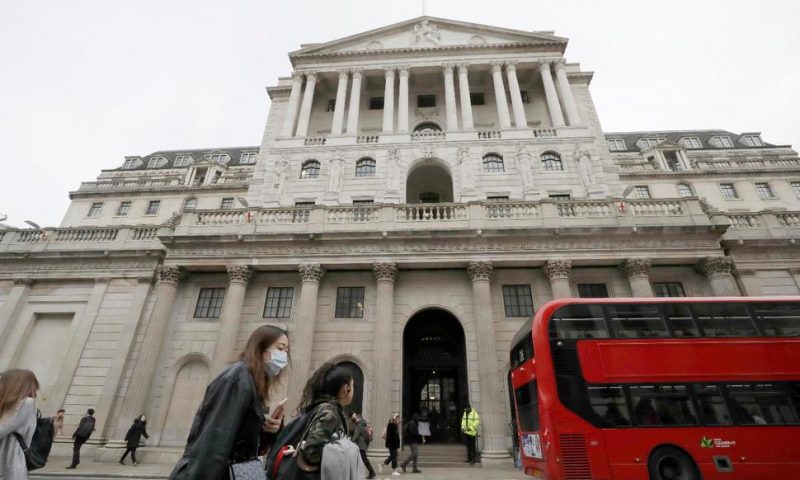The Bank of England has kept its main interest rate unchanged at the record low of 0.1% and says it expects the British economy to reach its pre-pandemic level by the end of the year.
LONDON — The Bank of England indicated Thursday that interest rates may be on the up soon as it painted a fairly rosy picture about the near-term prospects for the British economy following the lifting of lockdown restrictions in the wake of the rapid rollout of coronavirus vaccines.
In a statement accompanying its decision to keep the bank’s main interest rate unchanged at the record low of 0.1%, the rate-setting Monetary Policy Committee said “some modest tightening of monetary policy” over the coming period “is likely to be necessary to be consistent with meeting the inflation target sustainably in the medium term.”
The most recent figures showed the annual rate of inflation in the U.K. at 2.5% following a spike largely in energy prices. The latest forecasts show the bank expects inflation to pick up to 4% in 2021, which would be the highest level since 2011 and double the bank’s target.
“There are good reasons to believe that above-target inflation will be temporary,” Bank Governor Andrew Bailey told a press briefing. “If this outlook appears to be in jeopardy, the MPC will not hesitate to act.”
For now, the eight-member panel unanimously voted against any increase in rates. The panel also maintained the bank’s monetary stimulus at current levels though one of the eight members voted to reduce the level of asset purchases from 875 billion pounds ($1.2 billion) to 830 billion.
Armed with quarterly economic projections, also published Thursday, the rate-setting panel said “a waning impact” from COVID-19 would boost demand growth and help the British economy reach its pre-pandemic level by the end of the year.
It said the British economy is set to rebound by 7.25% this year following the lifting of lockdown restrictions, unchanged from its previous projection. However, it modestly upgraded its forecast for next year to 6% from 5.75%.
However, it cautioned that the more contagious delta variant, which has seen coronavirus infections spike sharply in the U.K. over the past couple of months, and voluntary social distancing could pose a risk to the outlook.
Overall, growth is expected to slow toward more normal rates in the months and years to come, partly reflecting lower government spending as many pandemic programs, such as a salary support scheme, end.
One uncertainty cited was how the economy will adjust to the end of the furlough scheme, which was introduced at the start of the pandemic last March to ensure unemployment didn’t rise substantially when lockdown restrictions were imposed. Under the program, the government paid 80% of the salaries of those workers unable to work because of lockdown measures.
The program, which is being phased out and due to end at the end of September, helped support over 11 million people but the number now is down below the 2 million mark as many sectors have reopened, notably hospitality. It kept a lid on unemployment, which remains relatively low at below 5%.
The committee also warned of a “more pronounced period” of above-target inflation in the near term than expected in May but said that its overall view is that cost pressures will prove “transitory.”
The bank also outlined its approach to removing economy-boosting measures when necessary, saying it would start to unwind its quantitative easing program when the man interest rate reaches 0.5%, which is lower than the previous threshold.
Economists said the first interest rate rise could come as soon as next year.
“If there is no other major wave of COVID-19 during the winter and the economy performs in line with the bank’s forecasts, the first rate rise is likely to come in the spring or early summer of next year,” said Ian Stewart, chief economist at Deloitte.

